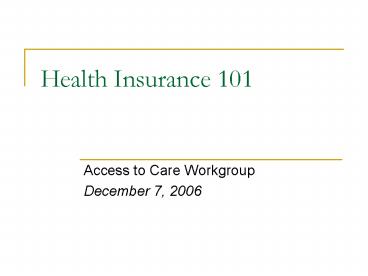Health Insurance 101 PowerPoint PPT Presentation
1 / 21
Title: Health Insurance 101
1
Health Insurance 101
- Access to Care Workgroup
- December 7, 2006
2
Agenda
- What Is It
- Who Has It
- How Does It Work
- Employer Sponsored Insurance
- Medicare
- Medicaid
- The Safety Net
3
Definition
- Insurance Social device in which a group of
individuals (insureds) transfer risk to another
party (insurer) in order to combine loss
experience which permits statistical prediction
of losses and provides payment of losses from
funds contributed (premiums) by all members who
transferred risk.
Source Risk Management Insurance, Etti Baranoff
4
Types of Health Insurance
Note Because people can have more than one type
of insurance, they are counted in more than one
category. Source US Census Bureau Current
Population Survey, 2005
5
Insurance Coverage Product CategoriesAlphabet
Soup
- Indemnitytraditional fee-for-service plans
- PPOpreferred provider organization
- HMOhealth maintenance organization
- POSpoint of service
- EPOexclusive provider organization
6
Employer Sponsored Insurance (ESI)
- The average monthly worker contribution for ESI
is 52 for single coverage and 248 for family
coverage - Employers can offer either self-funded or
fully-insured plans to employees - Typical benefits include primary care, specialty
care, prescription drugs, inpatient hospital
care, and some mental health benefits
Source Employer Health Benefits Survey 2006,
Kaiser Family Foundation
7
Employer Sponsored Insurance
- Health insurance premiums are increasing
year-over-year, but recent growth has slowed, a
combination of factors affect increases - Physician hospital cost increases because of
cost-shifting and new technologies - Utilization increases because of new technology,
flu season, new screenings, etc. - Overall political and economic changes
Source Employer Health Benefits Survey 2006,
Kaiser Family Foundation
8
How ESI WorksInsurer PerspectiveThe Annual Work
Cycle
9
Premium Time LineInsurer Perspective Rear View
Mirror Approach
Sell in Q-4 2006 for Q-1 2007 Effective Date
Experience Period For Claims
June 30, 2005
June 30, 2006
Sept 1, 2006
Oct 1, 2006
Jan 1, 2007
Actuarial Analysis of Historical Claims Trended
Forward to Coverage Period
Prepare Systems Materials for Market
10
How a Premium is DeterminedInsurer
PerspectiveSimple Example 1
Avg. Cost per Insured
Selling Admin. Expenses _at_12
Profit Load _at_5
PREMIUM
Assumes all trend factors applied from
experience period to roll forward to premium
period.
11
How a Premium is DeterminedInsurer
PerspectiveSimple Example 2
Avg. Cost per Insured
Selling Admin. Expenses _at_12
Profit Load _at_5
PREMIUM
Assumes all trend factors applied from
experience period to roll forward to premium
period.
12
Medicare Beneficiaries
- There are over 40 million Medicare beneficiaries,
they include - Persons over age 65
- Persons with disabilities
- Certain persons who are enrolled in Medicaid
(i.e. dual eligibles) - 9 in 10 beneficiaries report one or more chronic
illnesses and 25 of them report cognitive or
mental impairments
Source Medicare Chart Book 2005, Kaiser Family
Foundation
13
Medicare Services and Beneficiary Costs
Traditional Medicare
Source The AARP Public Policy Institute, 2006
Medicare Advantage Benefits and Premiums and
Medicare Chart Book 2005, Kaiser Family Foundation
14
Medicare and Medicaid Projected Costs
909 billion
392 billion
Source Congressional Budget Office Baseline
Projections, August 2006
15
Medicaid State Childrens Health Insurance
Program (SCHIP)
- Medicaid is a state and federal program providing
health insurance to low-income people, enrollees
include - Pregnant women, children, parents, aged, blind,
disabled, and medically needy - Medicaid enrollees
- 55 million (US)
- Over 700,000 (VA)
- Benefits can be traditional fee-for-service or
administered by managed care organizations
(depending on the region of the state)
- SCHIP, called FAMIS in Virginia, is a state and
federal program providing health insurance to
near low-income children (i.e. those who do not
meet Medicaid income thresholds) - SCHIP enrollees
- 4 million (US)
- 68,000 (VA)
- Benefits can be traditional fee-for-service or
administered by managed care organizations
(depending on the region of the state)
16
Aged, Blind, Disabled Groups Account For Almost
75 Of Medicaid Spending
Expenditures
Recipients
Aged
17
27
Aged
36
Blind Disabled
19
74
Adults
10
Blind Disabled
47
54
Children
Adults
7
18
Children
Notes FY 2004 recipient and expenditure data
17
Medicaid The Cost Of Serving The Elderly and
Disabled Is Substantially Greater Than The Cost
Of Care For Children
11,305
12,000
9,948
10,000
8,000
6,080
6,000
4,000
2,174
1,433
2,000
0
Blind Disabled
Aged
All Recipients
Children
Adults
Notes FY 2004 recipient and expenditure data
18
Medicaid SCHIPState and Federal Shares
- Program costs are shared by the state and federal
government - Federal share is higher in states with lower per
capita income - Virginias federal Medicaid match rate is 50
- For FAMIS, Virginias federal match rate is 67
19
Virginias Safety Net
- For some of the uninsured, primary care is
provided by - Community health centers (30)
- In 2005, 69,000 uninsured patients received care
- Migrant health centers
- Free clinics (53)
- In 2005, 61,000 uninsured patients received care
- Northern Virginia Community Health Network
- In 2005, 18,000 uninsured patients received care
- Individual practitioners providing charity care
20
Virginias Safety Net (cont.)
- Hospitals also provide care to the uninsured
- In Virginia, it is funded from a variety of
sources - Indigent Care Trust Fund
- State and Local Hospitalization Fund
- Special Medicaid payments
- DSH (Disproportionate Share Hospital) payments to
UVa and VCU - Shifts to private payers
21
Outlook for Health Coverage
- Todays system works for about 85 of the
population - ESI is still the dominant means of providing
coverage - An affordability crisis is here and will get
worse as premiums continue to outpace general
inflation - Medicare and Medicaid costs are growing, as is
enrollment, it will get worse as baby boomers age - This will put pressure on governments to
adequately fund care - Virginias safety net providers are still to few
and small to handle the full burden of the
uninsured - Cost trends drive affordability in both the
private and public sectors

